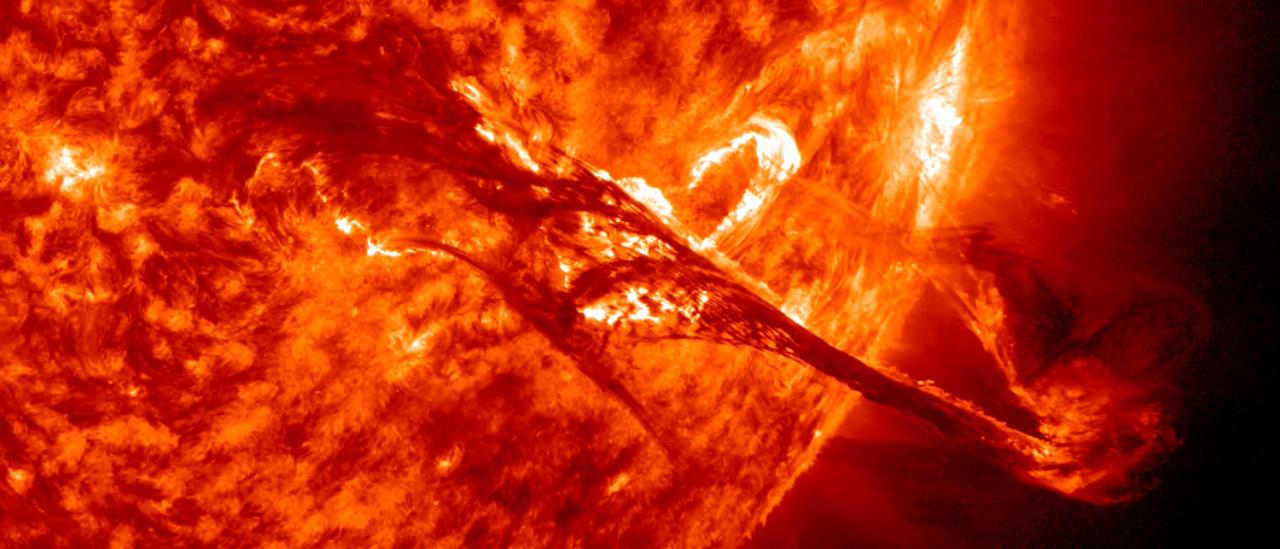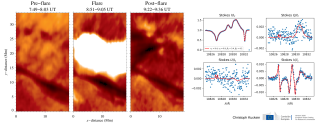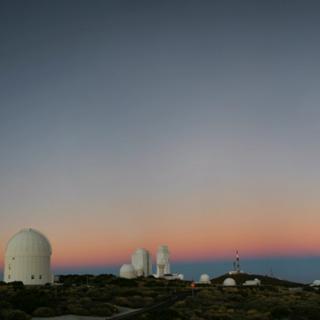Subvenciones relacionadas:
General
Los campos magnéticos son uno de los ingredientes fundamentales en la formación de estrellas y su evolución. En el nacimiento de una estrella, los campos magnéticos llegan a frenar su rotación durante el colapso de la nube molecular, y en el fin de la vida de una estrella, el magnetismo puede ser clave en la forma en la que se pierden las capas externas de forma dramática. En la vida adulta, el magnetismo da lugar a la actividad de las estrellas. Nuestro Sol tiene campos magnéticos que dan lugar a una actividad tan espectacular que es capaz de tener un impacto en la Tierra. Pero en otras estrellas, la actividad magnética es, en algunos casos, órdenes de magnitud más intensa que la solar, influenciando drásticamente el transporte de especies químicas y de momento angular, así como afectando posibles sistemas planetarios alrededor de éstas.
La finalidad de este Proyecto es estudiar diversas manifestaciones del campo magnético que se pueden observar en la atmosfera solar y en otras estrellas. Estas incluyen estructuras tan diversas como las manchas solares, los campos débiles presentes en el sol en calma o estructuras cromosféricas y coronales como los filamentos y las protuberancias. Así, se han ido abordando gradualmente los siguientes temas de investigación:
Magnetismo solar
- Estructura y evolución del campo magnético en manchas solares.
- Estructura y evolución del campo magnético en el Sol en calma.
- Estructura y evolución del campo magnético en la cromosfera y en estructuras cromosféricas (protuberancias, espículas,...)
- Estructura y evolución del campo magnético en bucles coronales.
- Estructura y evolución del campo magnético global del Sol. Estudios del ciclo de actividad magnética.
- Estudio empírico de la propagación de ondas magnetohidrodinámicas en el seno de estructuras magnéticas.
- Estudio empírico de mecanismos relacionados con el calentamiento de las capas externas del Sol.
- Estudio empírico de la influencia de la ionización parcial en la dinamica de la atmosfera solar.
- Implicación en el proyecto del Telescopio Solar Europeo.
Magnetismo estelar
- Desarrollo de métodos numéricos para el diagnóstico del campo magnético estelar, tanto en la superficie como en la cromosfera.
- Estudio del magnetismo en protuberancias estelares.
- Impacto del campo magnético en las últimas fases de la evolución estelar.
Miembros
Resultados
- Ondas espirales en manchas solares: Se han interpretado como ondas magnetoacústicas que se propagan desde el interior hasta capas atmosféricas siguiendo la dirección del campo magnético. Se ha caracterizado la topología del campo magnético de la mancha, descartando que la forma espiral sea consecuencia del retorcimiento de las líneas de campo (Felipe et al. 2019).
- Respuesta magnética a umbral flashes: Observaciones espectropolarimétricas simultáneas de las líneas cromosféricas He I 10830 y Ca II 8542 fueron usadas para estimar las fluctuaciones del campo magnético asociado a ondas de choque. Los choques provocan la expansión de las líneas de campo (Houston et al. 2018, incluye a A. Asensio Ramos).
Actividad científica
Publicaciones relacionadas
-
Returning magnetic flux in sunspot penumbrae
Aims: We study the presence of reversed polarity magnetic flux in sunspot penumbra. Methods: We applied a new regularized method to deconvolve spectropolarimetric data observed with the spectropolarimeter SP onboard Hinode. The new regularization is based on a principal component decomposition of the Stokes profiles. The resulting Stokes profiles
Asensio-Ramos, A. et al.Fecha de publicación:
12013 -
Wave Leakage and Resonant Absorption in a Loop Embedded in a Coronal Arcade
We investigate the temporal evolution of impulsively generated perturbations in a potential coronal arcade with an embedded loop. For the initial configuration we consider a coronal loop, represented by a density enhancement, which is unbounded in the ignorable direction of the arcade. The linearized time-dependent magnetohydrodynamic equations
Ballester, J. L. et al.Fecha de publicación:
12013 -
Comet McNaught C/2006 P1: observation of the sodium emission by the solar telescope THEMIS
Comet McNaught C/2006 P1 was the brightest comet of the last forty years when reaching its perihelion at an heliocentric distance of 0.17Â AU. Two days before this perihelion, at an heliocentric distance of 0.2Â AU, Themis, a French-Italian solar telescope in the Canary Islands, Spain, observed the Comet sodium emission of McNaught. The measured
Sainz Dalda, A. et al.Fecha de publicación:
42008 -
The 1.5 meter solar telescope GREGOR
The 1.5 m telescope GREGOR opens a new window to the understanding of solar small-scale magnetism. The first light instrumentation includes the Gregor Fabry Pérot Interferometer (GFPI), a filter spectro-polarimeter for the visible wavelength range, the GRating Infrared Spectro-polarimeter (GRIS) and the Broad-Band Imager (BBI). The excellent
Schmidt, W. et al.Fecha de publicación:
112012 -
GRIS: The GREGOR Infrared Spectrograph
This paper describes the main characteristics of GRIS (GREGOR Infrared Spectrograph), the grating spectrograph installed in the recently inaugurated (May 2012) 1.5-meter GREGOR telescope located at the Observatorio del Teide in Tenerife. The spectrograph has a standard Czerny-Turner configuration with parabolic collimator and camera mirrors that
Collados, M. et al.Fecha de publicación:
112012 -
The GREGOR Fabry-Pérot Interferometer
The GREGOR Fabry-Pérot Interferometer (GFPI) is one of three first-light instruments of the German 1.5-meter GREGOR solar telescope at the Observatorio del Teide, Tenerife, Spain. The GFPI uses two tunable etalons in collimated mounting. Thanks to its large-format, high-cadence CCD detectors with sophisticated computer hard- and software it is
Puschmann, K. G. et al.Fecha de publicación:
112012 -
Solar Fe abundance and magnetic fields. Towards a consistent reference metallicity
Aims: We investigate the impact on Fe abundance determination of including magnetic flux in series of 3D radiation-magnetohydrodynamics (MHD) simulations of solar convection, which we used to synthesize spectral intensity profiles corresponding to disc centre. Methods: A differential approach is used to quantify the changes in theoretical
Fabbian, D. et al.Fecha de publicación:
122012 -
Properties of convective motions in facular regions
Aims: We study the properties of solar granulation in a facular region from the photosphere up to the lower chromosphere. Our aim is to investigate the dependence of granular structure on magnetic field strength. Methods: We used observations obtained at the German Vacuum Tower Telescope (Observatorio del Teide, Tenerife) using two different
Kostik, R. et al.Fecha de publicación:
92012 -
Resolving the Internal Magnetic Structure of the Solar Network
We analyze the spectral asymmetry of Stokes V (circularly polarized) profiles of an individual network patch in the quiet Sun observed by Sunrise/IMaX. At a spatial resolution of 0farcs15-0farcs18, the network elements contain substructure which is revealed by the spatial distribution of Stokes V asymmetries. The area asymmetry between the red and
Martínez-González, M. J. et al.Fecha de publicación:
102012 -
LEMUR: Large European module for solar Ultraviolet Research. European contribution to JAXA's Solar-C mission
The solar outer atmosphere is an extremely dynamic environment characterized by the continuous interplay between the plasma and the magnetic field that generates and permeates it. Such interactions play a fundamental role in hugely diverse astrophysical systems, but occur at scales that cannot be studied outside the solar system. Understanding this
Teriaca, Luca et al.Fecha de publicación:
102012 -
Anomalous Circular Polarization Profiles in the He I 1083.0 nm Multiplet from Solar Spicules
We report Stokes vector observations of solar spicules and a prominence in the He I 1083 nm multiplet carried out with the Tenerife Infrared Polarimeter. The observations show linear polarization profiles that are produced by scattering processes in the presence of a magnetic field. After a careful data reduction, we demonstrate the existence of
Martínez-González, M. J. et al.Fecha de publicación:
112012 -
Hanle Effect for Stellar Dipoles and Quadrupoles
We derive exact expressions for the degree of lineal polarization over a resolved or integrated stellar disc due to resonance scattering and the Hanle effect from a dipolar or quadrupolar distribution of magnetic fields. We apply the theory of scattering polarization within the formalism of the spherical tensors representation for the density
Manso-Sainz, R. et al.Fecha de publicación:
112012 -
Fast events and waves in an active region of the Sun observed in Hα with high spatial resolution
Context: We study the chromosphere of an active region of the Sun in the Hα line. Aims: The development of new instrumentation and new methods of data analysis allows to scrutinize the dynamics of the solar chromosphere with high spatial, spectral, and temporal resolution. The observations we present shed light on some magneto-dynamic processes
Sánchez-Andrade Nuño, B. et al.Fecha de publicación:
82008 -
Detection of sea-serpent field lines in sunspot penumbrae
Aims:We investigate the spatial distribution of magnetic polarities in the penumbra of a spot observed very close to disk center. Methods: High angular and temporal resolution magnetograms taken with the Narrowband Filter Imager aboard Hinode are used in this study. They provide continuous and stable measurements in the photospheric Fe I 630.25
Sainz Dalda, A. et al.Fecha de publicación:
42008 -
The solar Ba{II} 4554 Å line as a Doppler diagnostic: NLTE analysis in 3D hydrodynamical model
Aims: The aim of this paper is to analyse the validity of the Dopplergram and λ-meter techniques for the Doppler diagnostics of solar photospheric velocities using the Ba II 4554 Å line. Methods: Both techniques are evaluated by means of NLTE radiative transfer calculations of the Ba II 4554 Å line in a three-dimensional hydrodynamical model of
Shchukina, N. G. et al.Fecha de publicación:
112009 -
Solar granulation from photosphere to low chromosphere observed in Ba II 4554 Å line
Aims: The purpose of this paper is to characterize the statistical properties of solar granulation in the photosphere and low chromosphere up to 650 km. Methods: We use velocity and intensity variations obtained at different atmospheric heights from observations in Ba II 4554 Å. The observations were done during good seeing conditions at the VTT at
Kostik, R. et al.Fecha de publicación:
112009 -
Simulations of Magnetoacoustic Pulsations in Atmospheres of Rapidly Oscillating Ap Stars
Rapidly oscillating Ap (roAp) stars exhibit an astrophysically interesting combination of strong, dipolar-like magnetic fields and high-overtone p-mode pulsations similar to the Sun. Recent time-resolved spectroscopy of these stars unravelled a complex picture of propagating magnetoacoustic pulsation waves, with amplitude and phase strongly
Khomenko, E. et al.Fecha de publicación:
102009 -
Morphology and evolution of umbral dots and their substructures
Context: Substructures - dark lanes and tails - of umbral dots (UDs) were predicted by numerical simulations of magnetoconvection and have been detected later in some observations. Aims: To provide constraints for realistic theoretical models of sunspot umbrae, we describe the observed properties and evolutionary characteristics of UDs (including
Sobotka, M. et al.Fecha de publicación:
92009 -
Numerical simulations of conversion to Alfvén waves in solar active regions
We study the coupling of magneto-acoustic waves to Alvén waves using 2.5D numerical simulations. In our experiment, a fast magnetoacoustic wave of a given frequency and wavenumber is generated below the surface. The magnetic field in the domain is assumed homogeneous and inclined. The efficiency of the conversion to Alfvén waves near the layer of
Khomenko, E. et al.Fecha de publicación:
12011 -
Modeling the Subsurface Structure of Sunspots
While sunspots are easily observed at the solar surface, determining their subsurface structure is not trivial. There are two main hypotheses for the subsurface structure of sunspots: the monolithic model and the cluster model. Local helioseismology is the only means by which we can investigate subphotospheric structure. However, as current linear
Moradi, H. et al.Fecha de publicación:
112010



